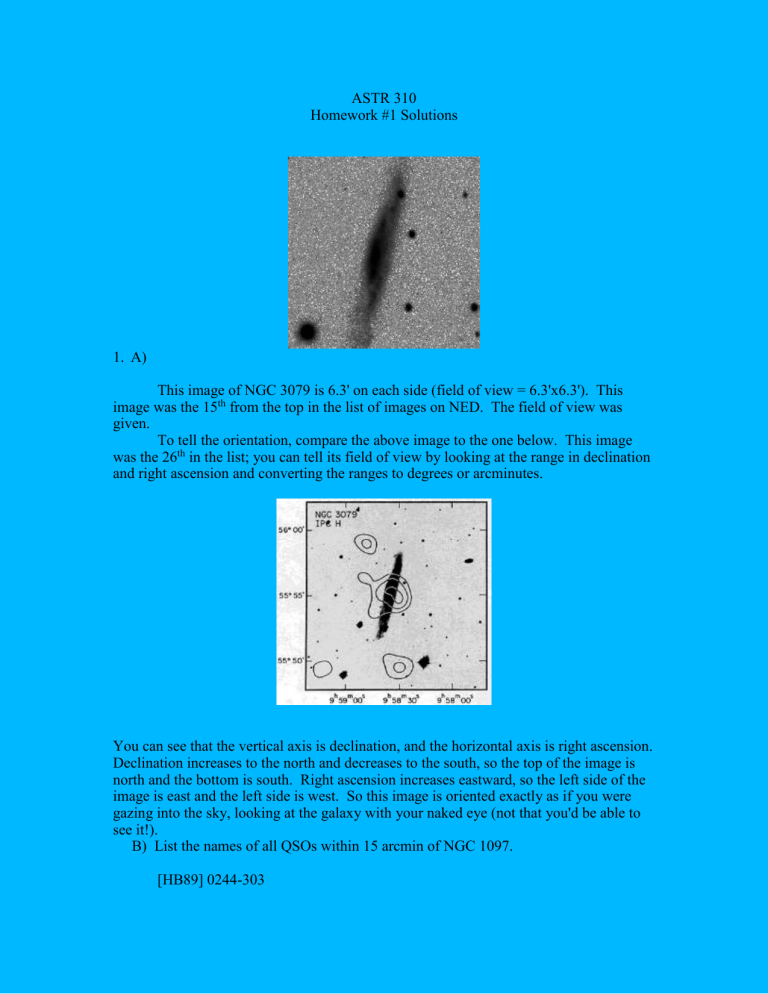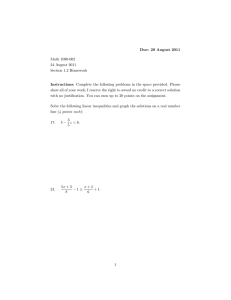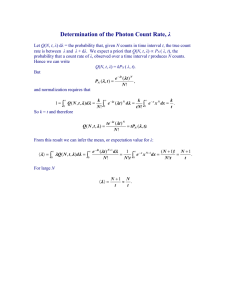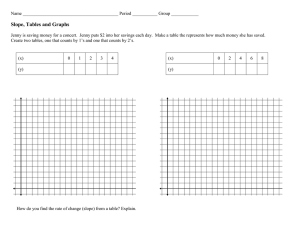Homework 1 Solutions

ASTR 310
Homework #1 Solutions
1.
A)
This image of NGC 3079 is 6.3' on each side (field of view = 6.3'x6.3'). This image was the 15 th from the top in the list of images on NED. The field of view was given.
To tell the orientation, compare the above image to the one below. This image was the 26 th in the list; you can tell its field of view by looking at the range in declination and right ascension and converting the ranges to degrees or arcminutes.
You can see that the vertical axis is declination, and the horizontal axis is right ascension.
Declination increases to the north and decreases to the south, so the top of the image is north and the bottom is south. Right ascension increases eastward, so the left side of the image is east and the left side is west. So this image is oriented exactly as if you were gazing into the sky, looking at the galaxy with your naked eye (not that you'd be able to see it!).
B) List the names of all QSOs within 15 arcmin of NGC 1097.
[HB89] 0244-303
2QZ J024658.5-300919
[HB89] 0224-302
2QZ J024547.6-300500
2QZ J024520.2-302115
2QZ J024524.8-302339
[HB89] 0243-302
2QZ J024557.3-300309
2QZ J024512.6-302033
2.
A) NGC 6821 is a spiral galaxy.
RA = 19h 44m 24.20s, dec = -6 deg 50' 02”
The dimensions given are 1.03, 0.04, and 135; we have to figure out what units they are in. By comparing with NED, you can figure out that the first number is the log of the angular size of the major axis (M) in 0.1 arcmin. The second is the log of the ratio of the major to minor axis (M/m). The third is the position angle, measured eastward of north. So the physical dimensions are:
[Remember: M(units of arcmin) = 10*M(units of 0.1 arcmin)]
1.03 = log(major axis in 0.1arcmin) = log(M*10) --> M = 1.072'
0.04 = log(ratio of major to minor axis) = log(M/m) --> M/m = 1.096 --> m = 0.978'
135 = position angle = 135 degrees
It is oriented such that its major axis is tilted 135 deg eastward of a vertical
(north-south) line, or 45 deg westward of the line. An example of position angle:
B) A Search for Very Extended Ionized Gas in Nearby Starburst and Active Galaxies,
Veilleux, S. et al., 2003, Astronomical Journal, Vol. 126, p. 2185
3.
The WFC3 has 2 channels, UV and IR. The UV channel detects wavelengths from
200-1000 nm, while the IR channel detects 800-1700 nm. The UV channel has a pixel scale of 0.04” and a field of view of 160”x160”. The IR channel's pixel scale is about
0.13”, with a field of view of 123”x139”.
4.
a) R = <n> = N = 20000 photons/5 minutes = 66.666667 photons/second b) N 20000 = 141.42 c) N = Rt = (20000 counts/5 minutes)*30 minutes = 120000 counts
N
N 120000 = 346.41
N
N
1
N
1
120000
= 0.00289
d) The Poisson distribution is
P n
N
N n e n!
N
. This is the probability that an event with rate R = N counts/sec, will happen n times in a second.
Probability of having zero counts per second: n = 0 counts, N = 66.666667 counts/sec
P
0
N= 66. 6667
N
0 e
0 !
N
1. 114 10
29
Probability of having 10 counts per second: n = 10 counts, N = 66.666667 counts/sec
P
10
N= 66. 6667
N
10 e
10 !
N
5. 325 10
18
Probability of detecting at least 10 counts in one second: The probability of detecting 10 or more counts per second is the same as 1 minus the probability of detecting less than 10 counts (0 to 9 counts). So to do this, find the probability of detecting zero counts, 1 count, 2 counts, ...9 counts, add those probabilities together, and subtract that number from 1 (because the probability of having 0 to infinite counts is 1).
9
P n 10
N= 66. 6667 1 P n< 10
N= 66.6667 1 i= 0
N i e i!
N
P n 10
1 e
66. 6667
66.6667
0
0 !
66. 6667
1
1 !
66. 6667
2
2 !
. . .
66. 6667
9
9 !
P n 10
1 9. 2109 10
19
0. 999999999999999999079



